
Do you often wonder what students really think about the teaching methods, courses, or campus facilities? The answers might surprise you—and the only way to find out is through student survey questions.
However, not all surveys are created equal—while all questions will give you at least some data, the right questions in the right format can make all the difference between getting truly useful insights and volumes of information with no practical use.
In this blog, I’ll discuss exactly what to ask and how to fulfill that objective.
Plus, you’ll get 25+ ready to use questions, practical tips on conducting surveys, and how to create your own in just a few minutes.
Ready? Let’s begin.
What Is a Student Survey?
A student survey is a tool designed to gather feedback directly from students about their experiences, opinions, or suggestions regarding various aspects of their education. But it’s more than just a set of questions on paper (or a screen)—it’s a conversation starter.
For example, “How interesting does this teacher make this subject?” Or “On a scale of 0 to 10, how excited are you about attending this class?”.
Think about it: How often do students get the chance to openly share their thoughts with educators?
Surveys offer students a platform to express what’s working and what’s not in a way that’s constructive and, more importantly, anonymous.
Whether it’s about classroom dynamics, teaching methods, or campus facilities, student surveys provide real insights that are often missed in everyday interactions.
These surveys can focus on academic experiences, extracurricular activities, or even mental health support, making them versatile tools for understanding what’s happening beyond grades and attendance.
What Are the Types of Student Surveys? 25+ Readymade Questions to Ask Students
Survey questions for students come in various forms, each designed to capture specific feedback.
The questions you ask depend on your research goals—whether it’s about academic satisfaction, campus life, or student well-being. Below are the main types of student surveys, along with 25+ survey questions examples for students and suggested formats for each category.
A. Academic Experience Surveys
These surveys focus on students’ experiences within the classroom, how they perceive their learning environment, and the overall quality of teaching.
Questions:
- How would you rate the overall quality of teaching in this course?
- ☐ Excellent
- ☐ Good
- ☐ Fair
- ☐ Poor
- Do you feel the course materials helped support your learning?
- ☐ Strongly Agree
- ☐ Agree
- ☐ Neutral
- ☐ Disagree
- ☐ Strongly Disagree
- How often do you feel engaged during lectures or class discussions?
- ☐ Always
- ☐ Often
- ☐ Sometimes
- ☐ Rarely
- ☐ Never
- What improvements would you suggest for this course?
- (Open-ended)
B. Student Satisfaction Surveys
These surveys measure how satisfied students are with their overall school or university experience, from academics to extracurriculars.
Questions:
- How satisfied are you with the quality of services offered by the school (e.g., library, IT support, counseling)?
- ☐ Very Satisfied
- ☐ Satisfied
- ☐ Neutral
- ☐ Unsatisfied
- ☐ Very Unsatisfied
- How likely are you to recommend this school to a friend?
- ☐ Extremely Likely
- ☐ Likely
- ☐ Neutral
- ☐ Unlikely
- ☐ Extremely Unlikely
- Which areas of student life do you feel need the most improvement? (Select all that apply)
- ☐ Academic Support
- ☐ Campus Facilities
- ☐ Extracurricular Activities
- ☐ Mental Health Support
- ☐ Career Services
C. Course Evaluation Surveys
These are typically conducted at the end of a semester or term, allowing students to give feedback on a specific course and its instructor.
Questions:
- Did the instructor explain the course material clearly?
- ☐ Always
- ☐ Often
- ☐ Sometimes
- ☐ Rarely
- ☐ Never
- Were the course objectives and expectations made clear at the beginning?
- ☐ Yes
- ☐ No
- How would you rate the instructor’s ability to encourage student participation?
- ☐ Excellent
- ☐ Good
- ☐ Fair
- ☐ Poor
- What did you find most challenging about this course?
- (Open-ended)
D. Campus Climate Surveys
These surveys focus on the overall environment of the school or university, including diversity, safety, and inclusivity.
Questions:
- Do you feel that your school promotes a diverse and inclusive environment?
- ☐ Strongly Agree
- ☐ Agree
- ☐ Neutral
- ☐ Disagree
- ☐ Strongly Disagree
- How safe do you feel on campus?
- ☐ Very Safe
- ☐ Somewhat Safe
- ☐ Neutral
- ☐ Somewhat Unsafe
- ☐ Very Unsafe
- Have you ever experienced or witnessed discrimination on campus?
- ☐ Yes
- ☐ No
- What could the school do to make the campus a more welcoming place?
- (Open-ended)
E. Mental Health and Well-being Surveys
Mental health is becoming a critical focus in education. These surveys help gauge how students are managing stress and other mental health challenges.
Questions:
- How often do you feel overwhelmed by school-related stress?
- ☐ Always
- ☐ Often
- ☐ Sometimes
- ☐ Rarely
- ☐ Never
- Do you feel that the school provides adequate mental health resources?
- ☐ Strongly Agree
- ☐ Agree
- ☐ Neutral
- ☐ Disagree
- ☐ Strongly Disagree
- On a scale of 0-10, how would you rate your overall well-being this semester?
| 0 | 1 | 2 | 3 | 4 | 5 | 6 | 7 | 8 | 9 | 10 |
4. What mental health resources would you like to see offered?
-
- (Open-ended)
F. Technology and Learning Tools Surveys
With the growing use of online learning platforms, it’s crucial to know how students perceive the technology tools used in their education.
Questions:
- How user-friendly do you find the school’s online learning platform?
- ☐ Very Easy
- ☐ Easy
- ☐ Neutral
- ☐ Difficult
- ☐ Very Difficult
- How reliable is your access to technology needed for learning (e.g., computers, Wi-Fi)?
- ☐ Always Reliable
- ☐ Often Reliable
- ☐ Sometimes Reliable
- ☐ Rarely Reliable
- ☐ Never Reliable
- What online tools or software do you find most helpful for your studies?
- (Open-ended)
G. Extracurricular Activities Surveys
These surveys focus on student involvement outside the classroom, such as sports, clubs, and other activities.
Questions:
- How satisfied are you with the variety of extracurricular activities offered?
- ☐ Very Satisfied
- ☐ Satisfied
- ☐ Neutral
- ☐ Unsatisfied
- ☐ Very Unsatisfied
- How often do you participate in extracurricular activities?
- ☐ Frequently
- ☐ Occasionally
- ☐ Rarely
- ☐ Never
- What types of extracurricular activities would you like to see added?
- (Open-ended)
- How can we improve your experience in the extracurricular activities programs?
- (Open-ended)
What Is the Importance of Student Survey Questions?
The question arises: why are student survey questions so important?
Simply put, good survey questions for students can act as a bridge between what educators think is happening and what students are actually experiencing. Without asking the right questions, it’s easy to miss critical insights that could shape how schools or universities function and improve.
Here are some prime benefits of incorporating student surveys into your curriculum.
-
Opening Channels of Communication
One of the biggest benefits of student surveys is that they open up lines of communication. In most classrooms or school settings, students might not feel comfortable sharing their concerns directly.
A well-designed survey gives students the opportunity to provide honest feedback in a safe, anonymous way. It’s like giving students a microphone to express themselves without fear of judgment.
Imagine this: A student who’s been struggling silently can use the survey to share their challenges. Suddenly, educators are aware and can intervene to provide help. This kind of connection wouldn’t have been possible without a survey.
-
Identifying Hidden Issues
Not all problems are visible from the surface. Sometimes, what students are going through—whether it’s related to their workload, mental health, or even social dynamics on campus—can be hard to detect without probing the right areas.
Survey questions focused on well-being or academic satisfaction can unearth these hidden issues. When schools identify areas that need attention early on, they can make changes that positively affect students’ lives rather than waiting until problems become too big to handle.
-
Driving Continuous Improvement
Surveys aren’t just a one-time fix; they’re part of a continuous cycle of improvement. When students provide feedback, schools and educators can reflect on what’s working and what’s not. It’s about evolving and adapting to meet students’ changing needs.
Think of it this way: If you’re running a restaurant, wouldn’t you want to know if your customers liked the food? The same applies to education. Regular student feedback helps keep the learning experience fresh, relevant, and engaging.
-
Enhancing Engagement and Ownership
When students are asked for their opinions, they feel valued and involved in their education.
This sense of ownership can lead to greater engagement in the classroom, better relationships with educators, and a stronger commitment to school life in general.
After all, when students see their feedback being taken seriously and implemented, they’re more likely to invest in their own learning.
-
Building a Positive School Culture
A healthy school culture is one where students feel heard, respected, and understood. Student surveys contribute directly to building this culture. By asking the right questions, schools can gauge how inclusive, supportive, and safe the environment feels for students.
Over time, this leads to an atmosphere where students thrive—not just academically but emotionally and socially as well.
-
Making Data-Driven Decisions
In the world of education, decisions can’t be based on assumptions or gut feelings alone. Data is key, and surveys provide exactly that—valuable, real-time data directly from students.
Schools can use this information to make informed, evidence-based decisions, whether it’s about improving teaching methods, revising school policies, or adding new support services.
This data-driven approach ensures that changes are meaningful and directly respond to students’ needs.
How to Conduct a Student Survey
Now that you are familiar with the best survey question types, you should follow these steps to create a compelling student survey.
-
Set your Goals and Objectives
For your surveys to yield higher response rates and accurate information, you need to set your goals right. This will help you decide the survey tone and the good survey questions for students you should choose.
For instance, if you want to know the student’s perception of the course, you should ask questions like, “How satisfied are you with the course material?”
Therefore, setting up your goals and objectives is the first thing you must do cautiously before creating a student survey.
-
Set Up a List of Student Survey Questions and Create the Survey
Once you have decided on your survey goals, you can choose the question types you can include to gather accurate information from the students. Now, make use of online survey software to start creating your survey.
Also, while drafting the school survey questions, keep the language as simple as possible. Use images, gifs, and conditional branching for the best survey experience.
-
Send the Survey
With online survey tools such as ProProfs Survey Maker and Qualaroo, you can easily share surveys via email, social media platforms, and direct links, or you can easily embed them on your company’s website, blog, or Facebook page.
-
Analyze the Responses
Once you start getting feedback from students, share the results with your team members and start analyzing the results via charts and graphs for quick reference. Look for the trends and patterns that will help you take necessary actions to improve the overall effectiveness of your school.
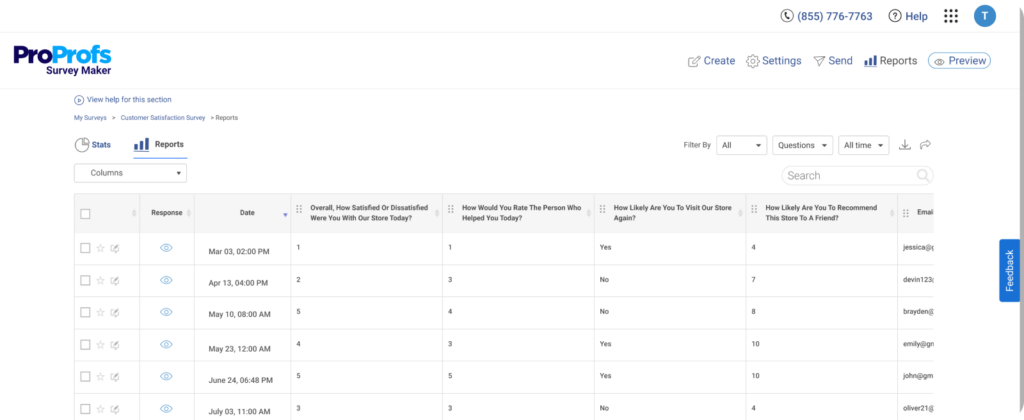
How to Create a Free Student Survey in Minutes
After deciding upon the survey goals and types of questions that you will be using, you need only select the right platform to create and share your survey. If you have the right tool at your disposal, you can effortlessly create a student survey in minutes.
Let’s get started with a visual representation:
Watch: How to Create Engaging Surveys Online with ProProfs Survey Maker – Free & Easy
Now, let’s look at the steps in detail.
Step 1: Choose a Free Online Tool
The best online survey software supports easy survey creation via an intuitive dashboard. They also provide valuable reports and rich insights.
Here, we have taken ProProfs Survey Maker as an example due to its advanced features like filters, drop-down options, and customized reports for easy research data analysis.
To create a survey quickly, select the “Create a survey” tab from the dashboard.

Step 2: Use Ready Made Templates
For a quick survey creation, choose a ready-made survey template that provides you with a starting point. Choose from a variety of educational survey templates available, including student surveys, faculty satisfaction, parent engagement, teacher feedback, course evaluation, and more.
You can also choose to create a survey from scratch.
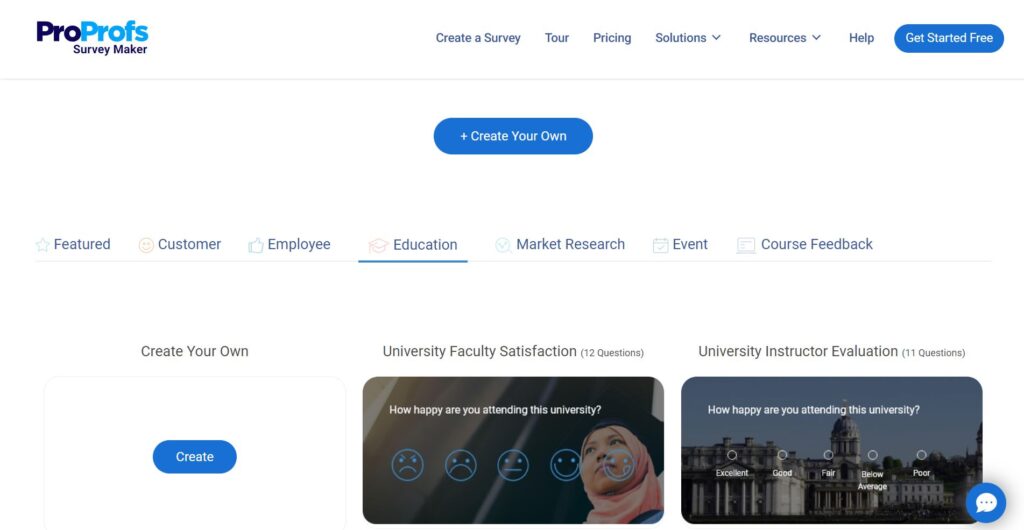
Step 3: Choose Your Questions
As discussed above, you can use various question types, including open-ended questions and closed-ended questions, to capture student opinions.
ProProfs Survey Maker has a library of question templates, including thousands of question types like multiple-choice, rating scales, NPS, Likert scale, and more, that makes survey creation a simple task.
You can also use the ProProfs AI Survey Generator to create a readymade student survey in minutes!
Here are some examples of some standard education survey questions:
- Would you recommend this course to other students?
- Overall, does this course meet your expectations?
- How satisfied are you with the hostel facilities?
Step 4: Survey Branding and Customization
Giving a personalized touch to a student survey is essential for better engagement. ProProfs Survey Maker allows you to choose various customization options to add the company logo, colors, and images.
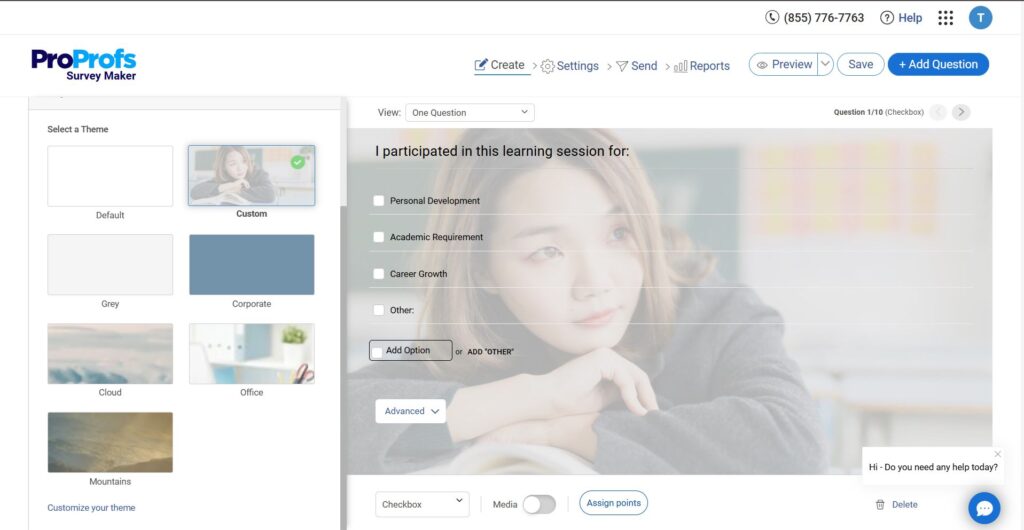
For creating a beautiful survey, you can select a predefined theme or upload your custom logo, backgrounds, fonts, etc.
Watch: How to Customize & Add Branding to Your Survey
Step 5: Apply Skip Logic
The success of a survey depends on how well it’s been tailored to the respondent. Advanced features like skip logic and branching help you create interactive surveys that only ask the user the relevant questions.
You can apply skip logic, also known as conditional branching, to present the following question to the students based on their answers to the current question. The answer to the previous question will tell you which question to present next.
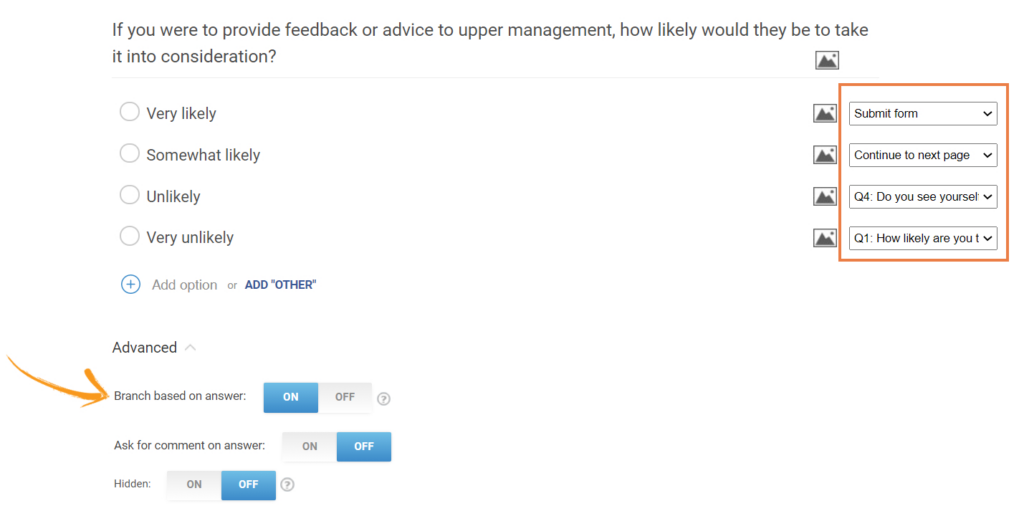
Skip logic benefits student surveys in the following ways:
- Get detailed insights with follow-up questions
- Filter out questions that are irrelevant to a particular student
- Offer personalized experience to each student
- Improve survey completion rates by keeping surveys short and to the point
Step 6: Preview and Send Your Survey
Once you have finished formatting, branding, and customizing your student survey, preview it before sending it to students. This will help you check for mistakes or logic issues.
Choose the Preview option from the top bar.
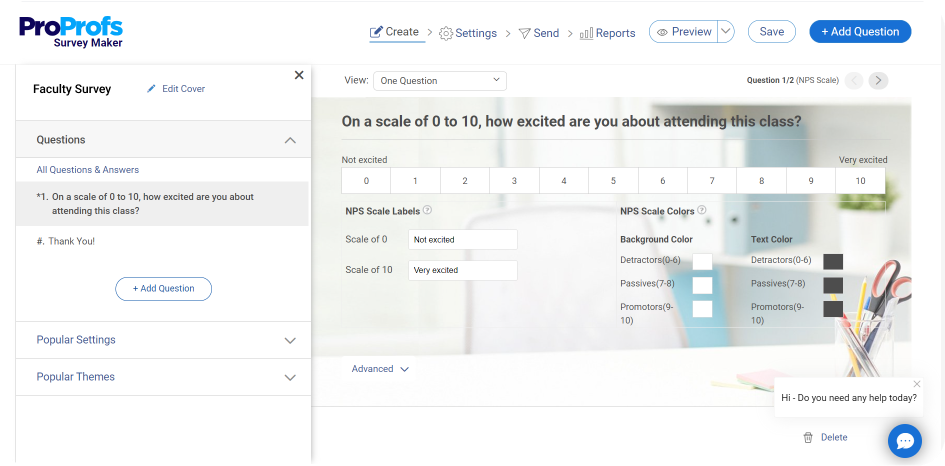
ProProfs Survey Maker lets you preview how your survey will appear on different screens, including desktops, tablets, smartphones, and popups.
Once you’ve completed the preview, you can click “Done.” Now, you are ready to send the survey and collect your responses.
Student Survey Tips to Increase Response Rates
Let’s face it – generic surveys often yield generic results. So, let’s go beyond the obvious and explore strategies that genuinely boost engagement:
Personalize Your Interactions:
- Tailored Invitations: Craft survey introductions that speak directly to the specific student group. Highlight why their unique perspective matters.
- Dynamic Questioning: Use skip logic to present relevant questions based on previous responses. This prevents survey fatigue and demonstrates genuine interest in individual viewpoints.
Offer Useful Incentives that Resonate:
- Beyond the Gift Card: Offer rewards that tap into students’ intrinsic motivations. Consider granting early access to study resources, organizing a pizza party with high-response groups, or showcasing select feedback in a student spotlight.
- Gamified Surveys: Infuse elements of fun and competition. Implement progress bars, interactive quizzes, or point systems to make participation engaging.
Time Your Communications Strategically:
- Opt for “Off-Peak” Hours: Send survey reminders during periods when students are less likely to be overwhelmed with academic tasks, like early evenings or weekends.
- Multi-Channel Outreach: Leverage a mix of platforms to reach students where they’re most active, including email, social media, in-class announcements, and even text messages (with opt-in).
Cultivate a Feedback Culture:
- Transparency is Key: Share survey findings and actionable steps taken as a result of student input. This builds trust and reinforces the value of participation.
- Student-Led Surveys: Empower student representatives to co-create and promote surveys. This fosters ownership and increases buy-in from peers.
Optimize the Survey Design:
- Mobile-First Approach: Ensure your survey displays and functions flawlessly on smartphones, as this is often the primary device for students.
- Concise and Impactful: Keep it short and sweet. Long, convoluted surveys are a surefire way to lose student attention.
Bonus Tip: Don’t underestimate the power of a heartfelt “thank you.” Express genuine gratitude for students’ time and insights.
By implementing these creative strategies, you’ll transform your student surveys from mundane obligations into opportunities for meaningful engagement and impactful feedback.
Transform the Learning Experience With the Right Student Survey Questions
To truly understand how to improve your educational model, it’s essential to listen to students—they often provide insights that can lead to meaningful transformation. That’s why student surveys are invaluable. They allow you to gather a wealth of thoughtful feedback with minimal effort.
The key to success is choosing the right set of survey questions, as this encourages students to share honest and useful responses. Their feedback helps you pinpoint areas for improvement while also highlighting what your institution is doing well.
To streamline the process, consider using a tool like ProProfs Survey Maker. With over 100 pre-built survey templates, it simplifies survey creation and distribution through platforms like social media, email, or your website. This makes gathering actionable feedback easier than ever!
I hope this blog has answered all of your questions successfully. Happy surveying!
Learn More About Student Survey Questions
How do you ask students for feedback?
To ask students for feedback, use clear and concise survey questions that encourage honest responses. Ensure the purpose of the survey is explained and emphasize that their input will help improve the learning experience. Distribute the survey through convenient platforms like email, learning management systems, or in-class forms, and offer incentives for participation to boost response rates.
What is a student satisfaction score?
A student satisfaction score measures how content students are with various aspects of their educational experience, such as teaching quality, resources, and campus facilities. It is typically gathered through surveys and quantified using a rating scale (e.g., 1 to 5 or 1 to 10). This score provides valuable insights into student well-being and areas for improvement.
Should student surveys be anonymous?
Yes, student surveys should ideally be anonymous. Anonymity encourages students to provide honest, candid feedback without fear of judgment or repercussions. This results in more accurate and actionable data, helping institutions make meaningful improvements.
FREE. All Features. FOREVER!
Try our Forever FREE account with all premium features!








